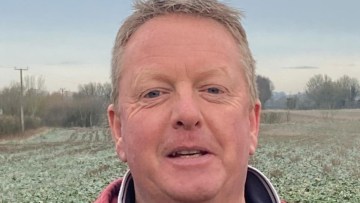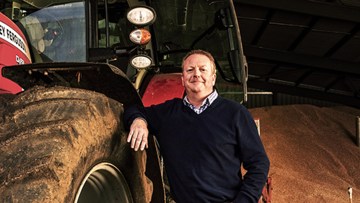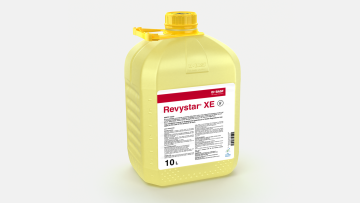RevYstories: Steve Crayston
30.05.2022

About Steve
Steve always knew he wanted to work in agriculture and joined the Youth Training Scheme after leaving school. However, he found the work to be lonesome and forged a career in the transport industry. His father and his uncle were running the family farm. When his father decided to step back, they both invited Steve to return, at the age of 30. Today, Steve, his uncle and cousin are farming two separate blocks totalling 1,000ha in north Essex. The business is as diverse as the crop rotation which includes Borage and echium, as well as the more usual arable crops of wheat, OSR, Spring Barley, spring oats, maize and sugar beet. Countryside Stewardship is steering the farm`s rotation.
The farm also has a glamping site, a 20-acre fishing lake and is one of just three propagation businesses supplying blackcurrants cuttings to Ribena growers, alongside numerous commercial lettings. The idea of spreading risk through diversification extends to Steve’s rotation which includes 250 acres of specialist crops, borage and echium. They are well suited to the farm’s varied soil types which can range from fairly heavy Essex clay running to sand, sometimes in the same field. Most of the farm, however, is medium to heavy clay.
When it comes to establishing crops, Steve favors a minimal approach. Having recently purchased another farm on the other side of valley, blackgrass is Steve’s most troublesome weed. He is also seeing pockets of rye grass. Regarding cereal diseases, Septoria is the main focus. Cabbage stem flea beetle is still a concern for his OSR, although aphids have replaced it as the number one pest in the last two years.

Steve's RevYstory
Steve has been involved in Real Results since 2019. “It’s a brilliant opportunity to work with experts and gain knowledge,” he says.
Ever since the Real Results trip to Germany, he has wanted to do meaningful trials on the home farm. “Seeing trials elsewhere is fine,” he notes. “But to really to know and understand what works on this farm – on our soils, with our weather, and crop rotation - we need to have trials here. In the 2020-2021 season, thanks to the Real Results Circle, we were given that opportunity”
Steve’s tramline trial on a crop of Elicit looked at Revystar® XE’s performance at different application rates at T2 timing. It compared the effects of Steve’s chosen field treatment on Revystar® XE at 0.8L/ha + tebuconazole at 0.25L/ha - with Revystar® XE at 1L/ha, and to explore how Revystar® XE can be used within a higher input program to push crop potential, Revystar® XE 1L/ha + tebuconazole at 0.25L/ha + extra foliar nitrogen fertiliser at 0.25L/ha.
“There was visibly more greening of the areas treated with Revystar® XE at 1L/ha, compared to the field standard. The higher application rate that also contained the foliar fertiliser looked greenest, but the effects on yield were marginal. This indicates that it was the fungicide that increased yield,” concludes Steve.
The crop treated with Revystar® XE at 1L/ha yielded on average 0.66t/ha more than the field standard at the rate of 0.8L/ha, showing the benefit of an appropriate fungicide dose at T2 in a season where many perceived Septoria pressure to be low until after T2 applications were made.
“This was our second year using Revystar® XE,” says Steve. “We`ve deployed it on the most responsive varieties to preserve yield potential and have seen a dose response both in the trial and elsewhere on the farm.”
“Ultimately new chemistry is another tool in the toolbox. Revystar® XE contains a new class of triazole which gives us the opportunity to have more robust programme and reduce resistance pressure.”
What's happening on Steve's Farm?
Early October’s wet weather made Steve wonder whether he was facing another difficult autumn. However, conditions dried up and he was able get the majority of his wheat crop sown.“We are now on-schedule and very pleased with establishment especially behind the borage and echium crops. With plenty of early growth, able to support lots of tillers, we’re hopeful we’re heading towards a good harvest,” he says.Varietal choice is a key aspect of Steve’s disease risk management strategy.
“This year we have KWS Extase, KWS Siskin and Elicit – which fits in behind the maize as it is good for fusarium - and we’re trying LG Astronomer for the first time,” he explains.
“We tend to choose varieties with high scores for Septoria and rusts, accepting that we sometimes have to compromise with mildew. At least we know we can control mildew relatively easily. Regardless of the levels of genetic resistance, we ensure crops receive a robust fungicide programme. We do like to take care of our wheat.
”Looking ahead to the spring fungicide programme, Steve will be guided by the season’s disease pressure, likely return on investment and product availability.
“I’m sure, however, that Revystar® XE will be the mainstay of our programme. Why wouldn’t it be? The trials this year have proven what we’ve seen elsewhere on the farm. There was greening of the crop and this appears to have translated into yield, especially where a higher dose of Revystar® XE was applied.”

